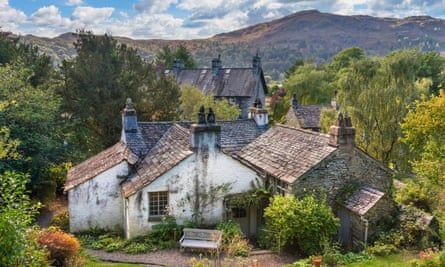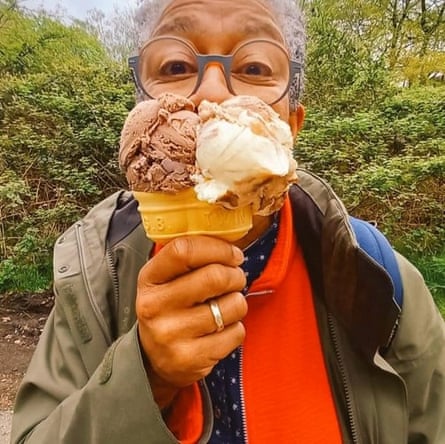‘I’m not afraid of anybody now’: the woman who revealed links between National Trust houses and slavery – and was vilified |
您所在的位置:网站首页 › A colonial past › ‘I’m not afraid of anybody now’: the woman who revealed links between National Trust houses and slavery – and was vilified |
‘I’m not afraid of anybody now’: the woman who revealed links between National Trust houses and slavery – and was vilified
Standing outside Dove Cottage in Grasmere in the drizzle, Prof Corinne Fowler seems a very unlikely looking fire starter. But that is exactly how anonymously apoplectic defenders of crown and country have tended to view her. Fowler was, in 2020, the co-author of a report into the colonial history of properties belonging to the National Trust. After which, as they say in the tabloids, all hell broke loose. At the moment her report was published, culture war arguments about the country’s past were already primed. The statue of the slave-trading philanthropist Edward Colston had lately been toppled into Bristol harbour; Black Lives Matter marches had brought an end to lockdown; footballers were taking the knee. For some on the right, Fowler’s report became (yet another) lightning rod for their anger. Most of the academic research in that report was already in the peer-reviewed public domain. Still, the professor was characterised in the Telegraph as being “at war with the past”. Nigel Farage accused her of “trashing” our nation (his own special subject). A group of 59 Conservative MPs and peers calling themselves, without any apparent irony, the “Common Sense Group” declared a “battle for Britain” against “subversives fuelled by ignorance and an arrogant determination to erase the past and rewrite the future”. Sir John Hayes, the group’s chair – and occupant of one of the safest Tory seats in England, South Holland and The Deepings in rural Lincolnshire – condemned Fowler’s report as “unpatriotic”. “History,” he wrote, “must neither be sanitised nor rewritten to suit ‘snowflake’ preoccupations.” (Preoccupations, I guess, such as recorded fact and evidential truth.)  A Restore Trust campaign ad featuring Nigel Farage. A Restore Trust campaign ad featuring Nigel Farage.The vitriol was only part of it. As a result of the report, two incendiary parliamentary debates were held about the purpose of the National Trust. A vocal pressure group with opaque funding, Restore Trust, was formed to attempt a takeover of the charity’s board in order to denounce “wokery” – in other words, any reference to the ways in which Downton Abbey fantasies may have been funded by violent colonial exploitation. Country house scones were monitored for signs of sedition – replacing English butter with continental margarine – and found wanting. To begin with, Fowler admits, she was, understandably, somewhat unnerved by all this outrage. Particularly as the comments sections of national newspaper websites were populated with suggestions about how she should be harmed – the words “woman” and “professor” in the same sentence seemed a particular problem for many of her trolls. For a while she was unable to leave home unaccompanied and was in regular dialogue with the police about threats to her safety. Eventually, however, and against most advice, she decided to do the most courageous thing: she started to answer her hate mail with courtesy, asking people exactly what upset or angered them and discussing in detail her own research and the historical evidence that supported her findings. Almost always, she says, these exchanges eventually ended cordially, with her correspondents wishing her well (one persistent offender even invited her and her son to visit his private wood in Norfolk). As a result, she came to the conclusion – much needed across all our public life – that “dialogue and openness are always the best antidotes to culture war”. It was with this belief in mind that Fowler embarked on her follow-up to that report: a dozen walks in rural Britain that are intended to open up a deeper sense of the history that her National Trust project research explored – in particular, the fact that just about every big house and surrounding village in our green and pleasant land “speaks volumes about colonialism’s distinctive phases, dimensions and impacts”. As Salman Rushdie once observed: “The trouble with the English is that their history happened overseas, so they don’t know what it means.” Fowler’s terrific, thoughtful, conversational book based on her walks, Our Island Stories, brings a lot of that understanding back home. “British colonial history,” she says, “requires emotionally intelligent approaches. It triggers everything from ancestral trauma to actual denial… for this reason knowledge is not something to be weaponised, but to be shared.”  Grasmere, Lake District, in an illustration circa 1890. Photograph: Universal Images Group/Getty Images Grasmere, Lake District, in an illustration circa 1890. Photograph: Universal Images Group/Getty ImagesHer walks have taken her from the Hebridean whisky isles, Jura and Islay (unearthing the ways they were shaped by the historical links with the Jamaican sugar, tobacco and slave trades), down through the Cotswolds (a landscape that reveals close ties to the East India Company) to the forgotten histories of Cornwall’s tin mines and their relationship to west Africa and the West Indies. I’m meeting Fowler at Grasmere to retrace the Lake District leg of her journey. She has bought a pack of gingerbread from the tiny shop beside St Oswald’s churchyard where the Wordsworths are buried. The gingerbread has been made and sold here to a “secret recipe” since 1854 – the rum for its butter and the ginger itself were shipped into Whitehaven port from Jamaica by Wordsworth’s patrons, the Lowther family, who had made a large part of their fortune in the slave trade. As we set off to walk around Grasmere and Rydal Water, between the houses in which the poet lived, Fowler cheerfully recounts relevant parts of that history. I happen to know a fair bit about Wordsworth’s life – I wrote a university dissertation on his revolutionary ideas about rural poverty – so am therefore doubly fascinated to discover the full story of his associations with colonial trade, which hardly figures in any of the literary histories.  Dove Cottage, home of the poet William Wordsworth and his sister, Dorothy. Photograph: Ian Dagnall/Alamy Dove Cottage, home of the poet William Wordsworth and his sister, Dorothy. Photograph: Ian Dagnall/AlamyThere are two strands to Fowler’s telling of it. The first involves Wordsworth’s younger brother John, who was a ship’s captain for the East India Company, with frequent lucrative voyages to China and the subcontinent, which helped to fund William’s early vocation (and supply drugs for friends including Coleridge and De Quincey). In 1805 John Wordsworth set sail for India and China, intending to secure his fortune by illicitly trading opium, on the company’s largest ship, the Abergavenny. But just off the coast of Weymouth, in a storm, the ship foundered on rocks and John and most of his crew drowned. The news came as a huge blow to William, not least because he was left with diminished means to support his sister, Dorothy, and his growing family. The poet replaced the funds he had hoped to receive from John’s colonial adventures with patronage from Sir William Lowther, a former Tory MP and major landowner, whose fortune also relied on colonial trade. The political compromises Wordsworth was required to make – to support life at the bigger house at Rydal Mount – not only in espousing the increasingly conservative views of his patron, but also, as Fowler reveals, trying to secure “Mississippi bonds” in cotton plantations for his daughter, fatally damaged his reputation as a radical (“Just for a handful of silver he left us,” Browning wrote in his poem The Lost Leader, “just for a riband to stick in his coat…”). Walking through John’s Grove, where William and Dorothy used to lie in the shade and look out over the lake to mourn their brother, Fowler reflects on the ways that in scholarly English departments “the writer’s precarious relationship to money is too often overlooked”. And if you follow that money in the 18th and 19th centuries, as she has done (not only for Wordsworth, but also – pearl-clutchers look away – for Jane Austen), it invariably leads back to the great engine of British capital from the 17th century on, the trade in tobacco and cotton and sugar – and in enslaved people. For her original walks Fowler chose companions with ancestral connections to empire, who helped her to see the villages, hills and fields in a new light. Her companion in the Lakes was the photographer and artist Ingrid Pollard. Back in the 1980s Pollard, a lover of the Lakes, had became increasingly frustrated at the absence of faces like hers in any of the postcards or depictions of the region. She created Pastoral Interlude, a photographic sequence featuring people of colour in the countryside. “I wandered lonely as a Black face in a sea of white”, one image is captioned.  Artist Ingrid Pollard, one of Fowler’s walking companions for her new book. Photograph: Courtesy of Corinne Fowler Artist Ingrid Pollard, one of Fowler’s walking companions for her new book. Photograph: Courtesy of Corinne FowlerPollard and Fowler became friends when they worked together on Fowler’s Colonial Countryside initiative, which brought kids from inner-city schools to country houses and asked them to examine their own biographies in relation to what they found there. “I loved,” Fowler says, “how Ingrid never walks in a straight line. She is always stopping to look at something in a hedge or by the side of the road. She’s a true photographer; she sees everything.” Colonial Countryside, funded by the Arts Council and the National Lottery, ran from 2018 until 2020. “For me, there is nothing better than hearing a range of British kids talking about what history means to them,” Fowler says. “All these different perspectives, and real hearts and minds stuff.” She remembers a trip to the Eastern Museum at Kedleston Hall, the collection of treasures that George Curzon, the former viceroy of India, had brought back from his travels. A young girl on her project from Derby walked in and immediately pointed to one of these objects and said “that’s lapis lazuli”. Fowler asked her how she knew. She said: “Well my grandma is from Afghanistan and she brought some pieces with her.” As part of Colonial Countryside, Fowler invited some of the children’s parents to the National Trust properties. “One or two, of south Asian heritage, cried when they saw some of the items and read what was written about them,” she says. “Several of the volunteers at the properties, who had been there for decades, said to me afterwards: ‘It made me realise for the first time that what we have here is actually more relevant to these people’s history than to ours.’” Some of what I have been writing about is quite hard to think about – but the context should make it a gentle bookCorinne FowlerThe Colonial Countryside work led directly to Fowler being commissioned to do a full audit of the history of National Trust houses. Of course, some of the truths she uncovered were not welcomed by some of the current beneficiaries of those estates. One or two got in touch demanding changes. One woman asked her to remove a whole section about her ancestral pile. Fowler laughs. “It was a strange argument. She did not dispute the fact that her family had indeed invested in a company which traded in enslaved people – by buying South Sea Company shares – but the fact was, the woman said, they had ended up losing out on that investment, so it wasn’t fair to say they had profited from slavery.” Fowler had to tell the woman that the aim of the report was not to inflict reputational damage on inherited fortunes, but to present a deeper understanding of the facts. As the historian David Olusoga pointed out, “History doesn’t care very much about our feelings… country houses are not a soft play area.”  Rydal Mount. Wordsworth’s precarious relationship with money led him to seek the patronage of a powerful local landowner. Photograph: Radharc Images/Alamy Rydal Mount. Wordsworth’s precarious relationship with money led him to seek the patronage of a powerful local landowner. Photograph: Radharc Images/AlamyWalking through the landscape, she says, rather than sitting in an archive describing it, is a good way of bringing these stories to full life. It also offers the kind of built-in natural therapy that Wordsworth would have recognised. “Some of what I have been writing about is quite hard to think about – but the context should make it a gentle book,” she says, “though I suppose I know in practice it will upset some people.” skip past newsletter promotionSign up to Observed Free weekly newsletterAnalysis and opinion on the week's news and culture brought to you by the best Observer writers |
【本文地址】
今日新闻 |
点击排行 |
|
推荐新闻 |
图片新闻 |
|
专题文章 |